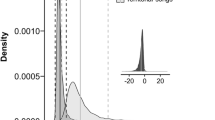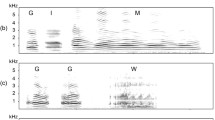Abstract
Many animal species have evolved signalling traits to mediate various intra-specific interactions. Signals are particularly important for inter-sexual selection, where females use male signalling traits to select mates. Female preferences are therefore a major selective force in the evolution of these male signals, and these preferences can facilitate rapid changes in these traits in an evolutionary timeframe. This introduction of high levels of variation in inter-sexual signals may overshadow any phylogenetic patterns present. Such shadowing effects, however, should be dependant on the characteristics of traits (e.g. morphological, physiological and behavioural). Using male advertisement calls from 72 species of anuran amphibians, we tested the levels of phylogenetic signal present for a variety of call features in relation to trait types, and for calls as whole units using phylogenetic principal components analysis. We found that most call features displayed some level of phylogenetic autocorrelation (or signal), with traits that are dependent on morphology having much stronger phylogenetic signals than those based on behaviour. In addition, when calls were analysed as whole units, closely related species were found to be similar to each other, indicating that phylogenetic patterns had not been cancelled out by selection via female preferences. We suggest that signal functions, such as indicating male quality (e.g. mediated by body size) to potential mates, may place constraints on the amount of variation that can be introduced by female preferences. More research, particularly studies on other taxa, will be required to elucidate whether the patterns found in anurans are general across the animal kingdom.



Similar content being viewed by others
References
Abouheif, E. (1999). A method for testing the assumption of phylogenetic independence in comparative data. Evolutionary Ecology Research, 1(8), 895–909.
Akre, K. L., Farris, H. E., Lea, A. M., Page, R. A., & Ryan, M. J. (2011). Signal perception in frogs and bats and the evolution of mating signals. Science, 333(6043), 751–752.
Alexander-Pyron, R., & Wiens, J. J. (2011). A large-scale phylogeny of Amphibia including over 2800 species, and a revised classification of extant frogs, salamanders, and caecilians. Molecular Phylogenetics and Evolution, 61(2), 543–583.
Andersson, M., & Simmons, L. W. (2006). Sexual selection and mate choice. Trends in Ecology and Evolution, 21(6), 296–302.
Beecher, M. D. (1989). Signaling systems for individual recognition—An information theory approach. Animal Behaviour, 38, 248–261.
Berven, K. A. (1981). Mate choice in the wood frog, Rana sylvatica. Evolution, 35(4), 707–722.
Blomberg, S. P., Garland, T., & Ives, A. R. (2003). Testing for phylogenetic signal in comparative data: Behavioural traits are more labile. Evolution, 57(4), 717–745.
Bosch, J., & De la Riva, I. (2004). Are frog calls modulated by the environment? An analysis with anuran species from Bolivia. Canadian Journal of Zoology, 82(6), 880–888.
Botero, C. A., Rossman, R. J., Caro, L. M., Stenzler, L. M., Lovette, I. J., de Kort, S. R., et al. (2009). Syllable type consistency is related to age, social status and reproductive success in the tropical mockingbird. Animal Behaviour, 77(3), 701–706.
Brown, J., Morales, V., & Summers, K. (2010). A key ecological trait drove the evolution of biparental care and monogamy in an amphibian. American Naturalist, 175, 436–446.
Byers, B. E. (2007). Extrapair paternity in chestnut-sided warblers is correlated with consistent vocal performance. Behavioral Ecology, 18(1), 130–136.
Capranica, R. R. (1965). The evoked vocal response of the bullfrog: A study of communication by sound. Cambridge: MIT.
Castellano, S., & Giacoma, C. (1998). Stabilizing and directional female choice for male calls in the European green toad. Animal Behaviour, 56, 275–287.
Cherry, M. I. (1992). Sexual selection in the leopard toad, Bufo pardalis. Behaviour, 120, 164–176.
Cocroft, R. B., & Ryan, M. J. (1995). Patterns of advertisement call evolution in toads and chorus frogs. Animal Behaviour, 49(2), 283–303.
Dieckmann, U., & Doebeli, M. (1999). On the origin of species by sympatric speciation. Nature, 400(6742), 354–357.
Dobzhansky, T. (1937). Genetics and the origin of species. New York: Columbia University Press.
Dyson, M. L., Passmore, N. I., Bishop, P. J., & Henzi, S. P. (1992). Male-behavior and correlates of mating success in a natural-population of African painted reed frogs (Hyperolius marmoratus). Herpetologica, 48(2), 236–246.
Fuzessery, Z. M. (1988). Frequency tuning in the anuran central auditory system. In B. Fritzsch, M. J. Ryan, W. Wilczynski, T. Hetherington, & W. Walkowiak (Eds.), The evolution of the amphibian auditory system (pp. 253–273). New York: Wiley.
Gavrilets, S., & Waxman, D. (2002). Sympatric speciation by sexual conflict. Proceedings of the National Academy of Sciences, 99(16), 10533–10538.
Gerhardt, H. C. (1994). The evolution of vocalization in frogs and toads. Annual Review of Ecology and Systematics, 25, 293–324.
Gray, D. A., & Cade, W. H. (2000). Sexual selection and speciation in field crickets. Proceedings of the National Academy of Sciences USA, 97(26), 14449–14454.
Hadfield, J. D. (2010). MCMC methods for multi-response generalized linear mixed models: The MCMCglmm R package. Journal of Statistical Software, 33(2), 1–22.
Hadfield, J. D., & Nakagawa, S. (2010). General quantitative genetic methods for comparative biology: Phylogenies, taxonomies and multi-trait models for continuous and categorical characters. Journal of Evolutionary Biology, 23(3), 494–508.
Higgins, J. P. T., Thompson, S. G., Deeks, J. J., & Altman, D. G. (2003). Measuring inconsistency in meta-analyses. BMJ, 327(7414), 557–560.
Jombart, T., Balloux, F., & Dray, S. (2010). Adephylo: New tools for investigating the phylogenetic signal in biological traits. Bioinformatics, 26(15), 1907–1909.
Kondrashov, A. S., & Kondrashov, F. A. (1999). Interactions among quantitative traits in the course of sympatric speciation. Nature, 400(6742), 351–354.
Krasnov, B. R., Poulin, R., & Mouillot, D. (2011). Scale-dependence of phylogenetic signal in ecological traits of ectoparasites. Ecography, 34(1), 114–122.
Lesbarreres, D., Merila, J., & Lode, T. (2008). Male breeding success is predicted by call frequency in a territorial species, the agile frog (Rana dalmatina). Canadian Journal of Zoology, 86(11), 1273–1279.
Lopez, P. T., & Narins, P. M. (1991). Mate choice in the neotropical frog, Eleutherodactylus coqui. Animal Behaviour, 41, 757–772.
Lynch, M. (1991). Methods for the analysis of comparative data in evolutionary biology. Evolution, 45(5), 1065–1080.
Marquez, R., & Bosch, J. (1997). Male advertisement call and female preference in sympatric and allopatric midwife toads. Animal Behaviour, 54, 1333–1345.
Martin, W. F. (1972). Muscular control of vocal tract during release signaling in toad Bufo valliceps. Journal of Morphology, 137(1), 1–27.
Mayr, E. (1982). The growth of biological thought. Diversity, evolution, and inheritance. Cambridge: Harvard University Press.
McLean, M. J., Bishop, P. J., & Nakagawa, S. (2012). Male quality, signal reliability and female choice: Assessing the expectations of inter-sexual selection. Journal of Evolutionary Biology,. doi:10.1111/j.1420-9101.2012.02533.x.
Pagel, M. (1999). Inferring the historical patterns of biological evolution. Nature, 401(6756), 877–884.
Passmore, N. I., Capranica, R. R., Telford, S. R., & Bishop, P. J. (1984). Phonotaxis in the painted reed frog (Hyperolius marmoratus). Journal of Comparative Physiology A, 154(2), 189–197.
Platz, J. E., & Lathrop, A. (1993). Body size and age assessment among advertising male chorus frogs. Journal of Herpetology, 27(1), 109–111.
R Development Core Team. (2010). R: A language and environment for statistical computing. Vienna, Austria: R Foundation For Statistical Computing.
Ryan, M. J. (1980). Female mate choice in a neotropical frog. Science, 209(4455), 523–525.
Ryan, M. J. (1986). Factors influencing the evolution of acoustic communication—Biological constraints. Brain Behaviour and Evolution, 28(1–3), 70–82.
Ryan, M. J. (1988). Constraints and patterns in the evolution of anuran acoustic communication. In B. Fritzsch (Ed.), The evolution of the amphibian auditory system (pp. 637–677). New York: Wiley.
Scheuber, H., Jacot, A., & Brinkhof, M. W. G. (2003). Condition dependence of a multicomponent sexual signal in the field cricket Gryllus campestris. Animal Behaviour, 65(4), 721–727.
Schwartz, J. J. (2001). Call monitoring and interactive playback systems in the study of acoustic interactions among male anurans. In M. J. Ryan (Ed.), Anuran communication (pp. 183–204). Washington, DC: Smithsonian Institution Press.
Searcy, W. A., & Nowicki, S. (2005). The evolution of animal communication: Reliability and deception in signaling systems. Princeton, New Jersey: Princeton University Press.
Smith, J. M., & Harper, D. (2003). Animal signals. Oxford: Oxford University Press.
van Doorn, G. S., Edelaar, P., & Weissing, F. J. (2009). On the origin of species by natural and sexual selection. Science, 326(5960), 1704–1707.
Wagner, W. E. (1989). Graded aggressive signals in Blanchard cricket frog—Vocal responses to opponent proximity and size. Animal Behaviour, 38, 1025–1038.
Wells, K. D. (1977a). The social behaviour of anuran amphibians. Animal Behaviour, 25, 666–693.
Wells, K. D. (1977b). Territoriality and male mating success in the green frog (Rana clamitans). Ecology, 58(4), 750–762.
Winquist, T., & Lemon, R. E. (1994). Sexual selection and exaggerated male tail length in birds. The American Naturalist, 143(1), 95–116.
Acknowledgments
We would like to thank the Macaulay Library, and the British Library for providing the sound files used in this analysis. We also thank the SN Behavioural Ecology lab members for discussion and comments on the manuscript. Finally, we would like to thank two anonymous reviewers for their useful comments and suggestions. M.J.M. is supported by the University of Otago Postgraduate Award.
Author information
Authors and Affiliations
Corresponding author
Electronic supplementary material
Below is the link to the electronic supplementary material.
Rights and permissions
About this article
Cite this article
McLean, M.J., Bishop, P.J. & Nakagawa, S. Assessing the Patterns of Evolution in Anuran Vocal Sexual Signals. Evol Biol 40, 141–149 (2013). https://doi.org/10.1007/s11692-012-9197-0
Received:
Accepted:
Published:
Issue Date:
DOI: https://doi.org/10.1007/s11692-012-9197-0




